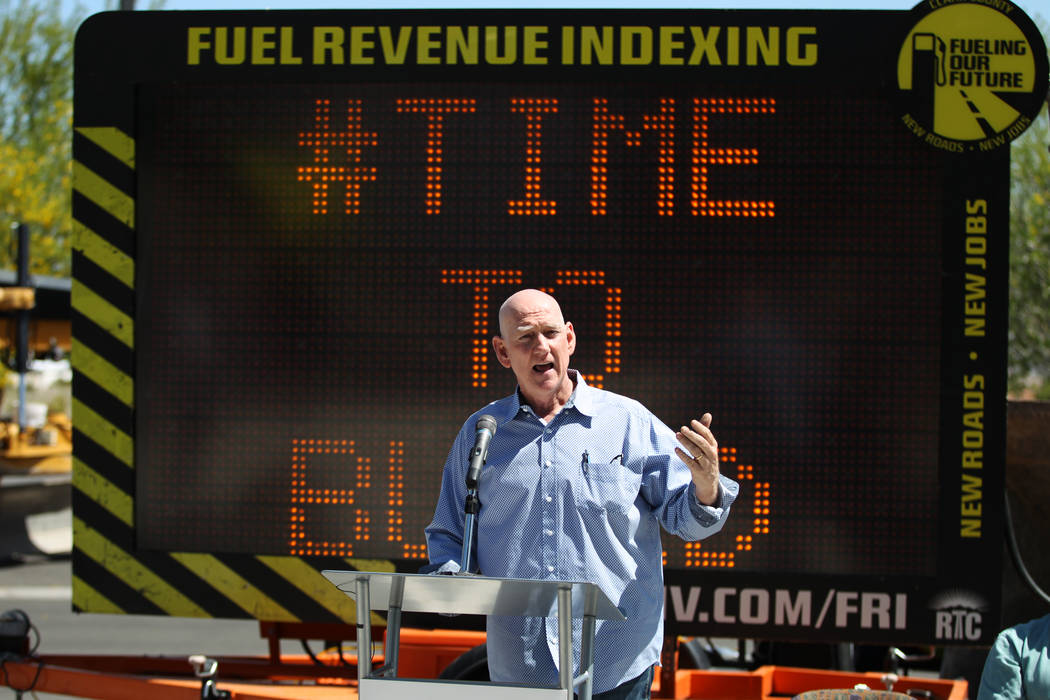RTC board wants Clark County to get fair share of Nevada road funds
Money generated by the voter-approved fuel revenue indexing tax is helping to pay for road projects across Clark County, but local transportation officials said Thursday that they hope to continue receiving a fair share of state funds.
Members of the Regional Transportation Commission of Southern Nevada’s board of directors raised the issue during a discussion about the tax, which is projected to generate about $3 billion by 2026 to help pay for nearly 200 street improvement projects.
RTC board chairman Larry Brown said he was putting the Nevada Department of Transportation “on notice” to provide a detailed list of road projects that are considered a priority for construction, and how they are funded. NDOT uses a mix of state and fuel revenue tax funds to pay for projects in Clark County.
Brown also said that NDOT should be forthcoming when a project in Clark County is delayed and earmarked funds are diverted to another part of the state.
Several RTC officials said they believe that happened fairly recently, as NDOT fast-tracks an environmental review for a project that calls for reconfiguring Reno’s version of the Spaghetti Bowl interchange at Interstates 80 and 580.
“There’s enough money for public infrastructure, streets and highways that nothing should get pushed back and delayed,” said Brown, a county commissioner. “I don’t buy anybody who says there is not enough funding. There is more than enough funding over the next decade than we’ve ever had in the state, and we have to start thinking differently on how to use that funding now.”
During the discussion, Henderson Public Works Director Robert Herr said he asked “multiple times” for a list of prioritized projects that NDOT had planned to present to the RTC on Thursday, but never received a response.
Specifically, Herr had wanted to work with NDOT in developing a list of projects aimed at bolstering safety along Boulder Highway, where nine pedestrians were fatally struck last year.
Additionally, Herr said he was told that NDOT would not be able to fund an environmental study to reconfigure the U.S. Highway 95 interchange at the 215 Beltway until 2020. As a result, Henderson is using a portion of its fuel indexing tax funds to start that review.
“If we wait, we find there are big gaps in the time frames,” Herr said. “We implore NDOT to work with us and coordinate these projects.”
Citing figures from NDOT’s capital improvement program, Herr said that Southern Nevada receives about 53 percent of state funds for transportation projects while making up more than 70 percent of the population. In comparison, he said Washoe County received 26 percent of allocated state transportation funds while making up 16 percent of the population,
“It just seems a little off balance for me,” said Henderson Mayor Debra March, who serves on the RTC board.
NDOT spokesman Tony Illia said the department allocated $459.9 million in project obligations statewide in fiscal 2017, with 60 percent going to Clark County, which makes up 73.5 percent of Nevada’s population.
In contrast, Washoe County received 17 percent of the funding while making up 15.4 percent of the state population.
Prior to that, Illia said, NDOT budgeted $2.7 billion in total project obligations between fiscal years 2013 and 2016, with 66 percent allocated to Clark County and 8.7 percent going to Washoe County.
“The department is responsible for designing, building and maintaining a safe and connected transportation network for all of Nevada, spanning a 110,000-square-mile-area over 17 counties, 19 unincorporated municipalities, and 128 cities,” Illia said. “We are entrusted with serving everyone in the state without prejudice.”
Contact Art Marroquin at amarroquin@reviewjournal.com or 702-383-0336. Find @AMarroquin_LV on Twitter.
Paying more at the pump
Gasoline taxes in Clark County will jump 1.3 cents per gallon starting July 1, thanks to the annual increase brought by the fuel revenue indexing tax approved in 2016.
Prior to 2014, county drivers were already paying 52 cents per gallon of gas to cover federal, state and county taxes and fees. Another 10 cents has since been tacked on because of the fuel revenue index tax that was approved in 2013 by county commissioners to raise up to $800 million over three years for local road improvements.
Clark County voters approved Question 5 in November 2016, allowing for a 10-year extension of the fuel revenue index tax. The yearly tax increases are based on the annual inflation rate forecast for the producer price index, which measures the rising cost in construction, commodity markets and other industries. About $3 billion is expected to be generated by 2026 to help pay for nearly 200 regional transportation projects.

















